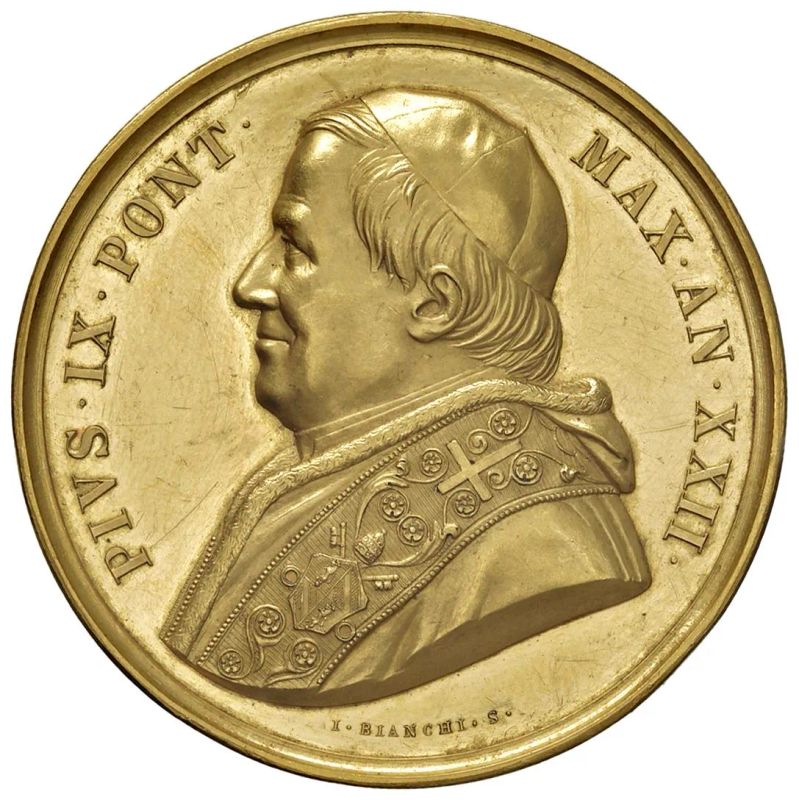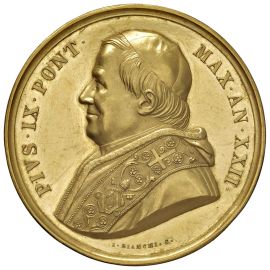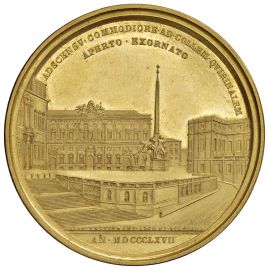ROMA. PIO IX (1846-1878) MEDAGLIA ANNO XXII (1867) PER LA REALIZZAZIONE DELLA SCALINATA DI PIAZZA DEL QUIRINALE (OPUS IGNAZIO BIANCHI)
ROMA. PIO IX (1846-1878) MEDAGLIA ANNO XXII (1867) PER LA REALIZZAZIONE DELLA SCALINATA DI PIAZZA DEL QUIRINALE (OPUS IGNAZIO BIANCHI)
Au gr.51,17 Ø mm.440 PIVS IX PONT MAX AN XXII Busto a s. con zucchetto, mozzetta e stola ornata; sotto nel giro I BIANCHI F. R/ ADSCENSV COMMODIORE AD COLLEM QVIRINALEM APERTO EXORNATO Veduta della piazza del Quirinale con, in primo piano, la nuova scalinata; sullo sfondo il palazzo della Consulta e, sopra, VIRG VESPIGNANI ARCH I BIANCHI S. Es. AN MDCCCLXVII. Bartolotti E867.
Rarissima FDC Very rare MS
Per agevolare l'accesso alla piazza del Quirinale e al palazzo pontificio, fu costruita un'ampia scalinata che collegava il piazzale con le vie sottostanti. L'opera, progettata dall'architetto Virginio Vespignani, bene si armonizzò con l'ambiente circostante e con il vicino monumento dei Dioscuri. Fu Sisto V a volervi sistemare questo gruppo marmoreo, replica romana di età imperiale di statue greche del V sec. a.C., trovato nelle vicine terre di Costantino. Due secoli dopo Pio VI aggiunse l'obelisco che faceva parte del mausoleo di Augusto. Nel 1818, Pio VII completò il monumento con una fontana e una vasca di granito trovata in un tempio del Foro Romano. Proprio per la presenza delle statue dei Dioscuri con i due cavalli, il rione, fin dal seicento, venne chiamato "Montecavallo".
To facilitate access to the Quirinale square and the papal palace, a wide staircase was built that connected the square with the streets below. The work, designed by the architect Virginio Vespignani, harmonized well with the surrounding environment and with the nearby monument of the Dioscuri. It was Sixtus V who wanted to place this marble group there, a Roman replica from the imperial age of Greek statues from the 5th century. BC, found in the nearby lands of Constantine. Two centuries later Pius VI added the obelisk which was part of the mausoleum of Augustus. In 1818, Pius VII completed the monument with a fountain and a granite basin found in a temple in the Roman Forum. Precisely because of the presence of the statues of the Dioscuri with the two horses, the district was called "Montecavallo" since the seventeenth century.




